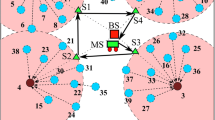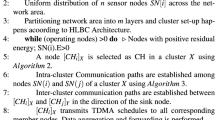Abstract
The energy consumption of each node in the sensor network can be effectively balanced by using mobile sinks for data gathering, thus avoiding resulting in energy hole problem. This paper proposes a virtual grid margin optimization and energy balancing (VGMEB) protocol for mobile sinks to balance zthe energy consumption in wireless sensor networks. VGMEB achieves high energy efficiency by designing a virtual grid margin method and determining a novel evaluation model for cluster head selection. In addition, an approach in multiple attribute decision making based on relative entropy is integrated for determining the weight value of each metric. The experimental results show that VGMEB outperforms these protocols and it can efficiently mitigate the energy hole problem and prolong the network lifetime.










Similar content being viewed by others
References
Bhadauria D, Tekdas O, Isler V (2011) Robotic data mules for collecting data over sparse sensor fields. J Field Robot 28(3):388–404
Chen HY, Shi QJ, Tan R (2010) Mobile element assisted cooperative localization for wireless sensor networks with obstacles. IEEE Trans Wirel Commun 9(3):956–963
Gandham SR, Dawande M, Prakash R et al (2003) Energy efficient schemes for wireless sensor networks with multiple mobile base stations. Global Tele-Communications Conference:377–381
Gao S, Zhang HK (2011) Optimal path selection for mobile sink in delay-guaranteed sensor networks. J Electron 39(4):742–747
Gao S, Zhang HK (2011) Optimal path selection for mobile sink in delay-guaranteed sensor networks. Acta Electron Sinica 39(4):742–747
Gao S, Zhang H, Das SK (2011) Efficient data collection in wireless sensor networks with path-constrained mobile sinks. IEEE Trans Mob Comput 10(4):592–608
He L, Pan JP, Xu JD (2013) A progressive approach to reducing data collection latency in wireless sensor networks with mobile elements. IEEE Trans Mob Comput 12(7):1308–1320. doi:10.1109/TMC.2012.105
Heinzelman WB, Chandrakasan AP, Balakrishnan H (2002) An application-specific protocol architecture for wireless microsensor networks. IEEE Trans Wirel Commun 1(4):660–670
Jain S, Shah RC, Borriello G (2006) Exploiting mobility for energy efficient data collection in sensor networks. Mob Netw Appl 11(3):327–339
Li J, Mohapatra P (2007) Analytical modeling and mitigation techniques for the energy hole problem in sensor networks. Pervasive Mob Comput 3(3):233–254
Luo J, Hubaux JP (2005) Joint mobility and routing for lifetime elongation in wireless sensor networks. Proceedings of the 24th Annual Conf of the IEEE Computer and Communications Societies, Miami:1735─1746
Luo J, Panchard J, Piorkowski M et al (2006) Mobi-route: routing towards a mobile sink for improving lifetime in sensor networks. Proc. of the Int’l Conf on Distributed Computing in Sensor Systems
Marta M, Cardei M (2008) Using sink mobility to increase wireless sensor networks lifetime. IEEE International Symposium on World of Wireless, Mobile and Multimedia Networks:1–10
Meng ZL, Wang S, Wang Q (2009) Research on the moving strategy for mobile sink in cluster wireless sensor networks. J Huazhong Univ Sci Technol: Nat Sci Edn 37(6):67–70
Mirela M, Mihaela C (2009) Improved sensor network lifetime with multiple mobile sinks. Pervasive Mob Comput 5(5):542–555
Olariu S, Stojmenovic I (2006) Design guidelines for maximizing lifetime and avoiding energy holes in sensor networks with uniform distribution and uniform reporting. Proc of IEEE Int’ Conf on Computer Communications. Catalunya: IEEE Press:2505–2516
Sajjanhar U, Mitra P (2007) Distributive energy efficient adaptive clustering protocol for wireless sensor networks. Proceedings of the 2007 International Conference on Mobile Data Management:326–330
Shi GT, Liao MH (2007) Movement-assisted data gathering Scheme with load-balancing for sensor networks. J Softw 18(9):2235–2244
Somasundara AA, Kansal A, Jea DD (2006) Controllably mobile infrastructure for low energy embedded networks. IEEE Trans Mob Comput 5(8):958–973
Stefano B, Alessio C, Emanuel M et al (2008) Controlled sink mobility for prolonging wireless sensor networks lifetime. Wirel Netw 14(6):831–858
Wang W, Srinivasan V, Chua KC (2005) Using mobile relays to prolong the lifetime of wireless sensor networks. Proceedings of the 11th annual international conference on Mobile computing and networking:270–283
Wang GJ, Wang T, Jia WJ (2009) Adaptive location updates for mobile sinks in wireless sensor networks. J Super Comput 47(2):127–145
Xing G, Wang T, Jia W et al (2008) Rendezvous design algorithms for wireless sensor networks with a mobile base station. Proceedings of the 9th ACM international symposium on Mobile ad hoc network-ing and computing[C]. ACM:231–240
Yong D, Chen W, Li X (2010) Using mobile beacons to locate sensors in obstructed environments. J Parallel Distrib Comput 70(6):644–656
Yu ZH, Liu Y, Ji M et al (2009) An energy-efficient distributed clustering algorithm for wireless sensor networks. Control Decis 24(9):1436–1440
Zeng ZW, Chen ZG, Liu AF (2010) Energy-hole avoidance for WSN based on adjust transmission power. Chin J Comput 33(1):12–22
Zheng W, Liu SY, Kou XL (2010) Dynamic mobile agent routing algorithm in sensor network. Control Decis 25(7):1035–1039
Zhong Z, Luo DY, Liu SQ et al (2010) An adaptive localization approach for wireless sensor networks based on Gauss-Markov mobility model. Acta Automat Sin 36(11):1557–1568
Acknowledgments
This work was supported by Science and Technology Project of Guangdong Province under Grant No. 2013B010401012, Commissioned Development Project of China State Construction Engineering Corporation Limited under Grant No. 71010306 & 71020355, Science and Technology Project of Shenzhen under Grant No. JCYJ20140424173418463. The authors gratefully acknowledge the helpful comments and suggestions of the reviewers, which have improved the presentation.
Author information
Authors and Affiliations
Corresponding author
Rights and permissions
About this article
Cite this article
Tang, C., Yang, N. Virtual grid margin optimization and energy balancing scheme for mobile sinks in wireless sensor networks. Multimed Tools Appl 76, 16929–16948 (2017). https://doi.org/10.1007/s11042-016-3596-7
Received:
Revised:
Accepted:
Published:
Issue Date:
DOI: https://doi.org/10.1007/s11042-016-3596-7




